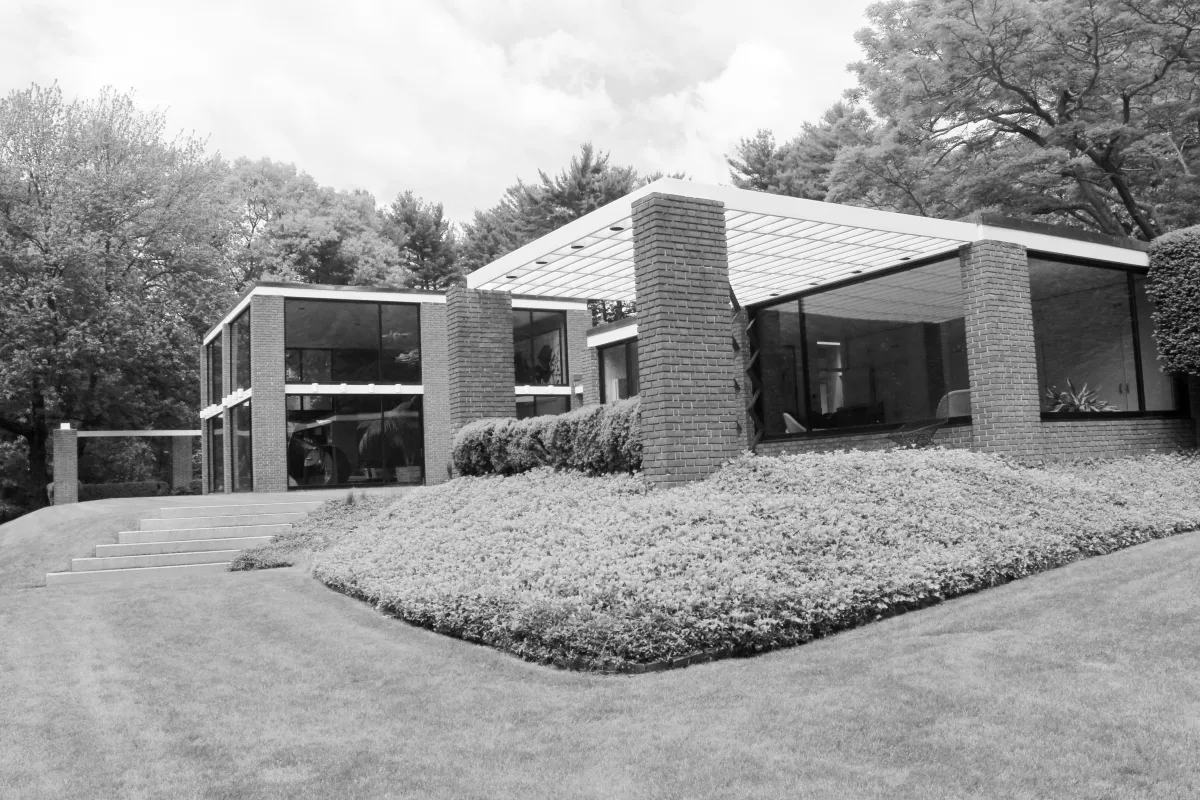Bill Matassoni
"You always have two choices: your commitment versus your fear."
Sammy Davis Jr.
"You always have two choices:
your commitment versus your fear."
Sammy Davis Jr.

A PHILIP JOHNSON GLASS HOUSE
“My wife Pamela and I own a house designed by Philip Johnson. Johnson was the most prominent of a group of architects who developed “mid- century modern” design. They were called the Harvard Five—Johnson, Marcel Breuer, Landis Gores, John Johansen and Eliot Noyes. All of them settled in and around New Canaan, Connecticut or spent weekends there. The houses they built were controversial and not always well received. There were no curves, only corners, open spaces and flat roofs. Sometime in the mid-’40s, Johnson was challenged by his mentor, Ludwig Mies van der Rohe, to build a house of glass. He did in 1948-’49 and that house, the Glass House, is one of the most famous houses in America.
In the early ’50s, a wealthy French family asked Johnson to design a house for them. It would eventually become ours. According to Johnson, they said, “We like your little house of glass, but we want a glass villa. We are European and we have a family.” Johnson, on one of several visits he made to our house, told us he wasn’t initially sure he could do that. But then, he said, he figured it out. He laid the house out on a grid of 16- foot squares defined by steel and brick pillars. Some of these squares were “inside,” some outside on brick terraces, and some on grass that extended to the end of the grid. What Johnson did was effectively redefine what was inside and out. In the original Glass House, the glass itself demarcated what was in and out. In ours, with its 12 tons of glass, the boundaries were the pillars that extended beyond the living spaces. “You realize,” he once remarked to us, “that I was breaking up the Miesien cube when I built your house.” We laughed. “Of course!”
So, several years after Johnson defined a new space for architecture with his Glass House, he was redesigning it again with ours. I suspect that this is what great marketers do. They literally see new dimensions for how value is measured and pricing is set. They figure out where in the new space they want their products and services to be. They are conceptual architects. And in many ways, they are also rebels. They are not content with adjustments. I can’t prove this, of course, and goodness knows marketing would not survive without product extensions that are improvements along existing dimensions.”
From Bill’s memoir, Marketing Saves The World.
A PHILIP JOHNSON GLASS HOUSE

“My wife Pamela and I own a house designed by Philip Johnson. Johnson was the most prominent of a group of architects who developed “mid- century modern” design. They were called the Harvard Five—Johnson, Marcel Breuer, Landis Gores, John Johansen and Eliot Noyes. All of them settled in and around New Canaan, Connecticut or spent weekends there. The houses they built were controversial and not always well received. There were no curves, only corners, open spaces and flat roofs. Sometime in the mid-’40s, Johnson was challenged by his mentor, Ludwig Mies van der Rohe, to build a house of glass. He did in 1948-’49 and that house, the Glass House, is one of the most famous houses in America.
In the early ’50s, a wealthy French family asked Johnson to design a house for them. It would eventually become ours. According to Johnson, they said, “We like your little house of glass, but we want a glass villa. We are European and we have a family.” Johnson, on one of several visits he made to our house, told us he wasn’t initially sure he could do that. But then, he said, he figured it out. He laid the house out on a grid of 16- foot squares defined by steel and brick pillars. Some of these squares were “inside,” some outside on brick terraces, and some on grass that extended to the end of the grid. What Johnson did was effectively redefine what was inside and out. In the original Glass House, the glass itself demarcated what was in and out. In ours, with its 12 tons of glass, the boundaries were the pillars that extended beyond the living spaces. “You realize,” he once remarked to us, “that I was breaking up the Miesien cube when I built your house.” We laughed. “Of course!”
So, several years after Johnson defined a new space for architecture with his Glass House, he was redesigning it again with ours. I suspect that this is what great marketers do. They literally see new dimensions for how value is measured and pricing is set. They figure out where in the new space they want their products and services to be. They are conceptual architects. And in many ways, they are also rebels. They are not content with adjustments. I can’t prove this, of course, and goodness knows marketing would not survive without product extensions that are improvements along existing dimensions.”
From Bill’s memoir, Marketing Saves The World.
Bill Matassoni | Copyright 2025
Bill Matassoni | Copyright 2025